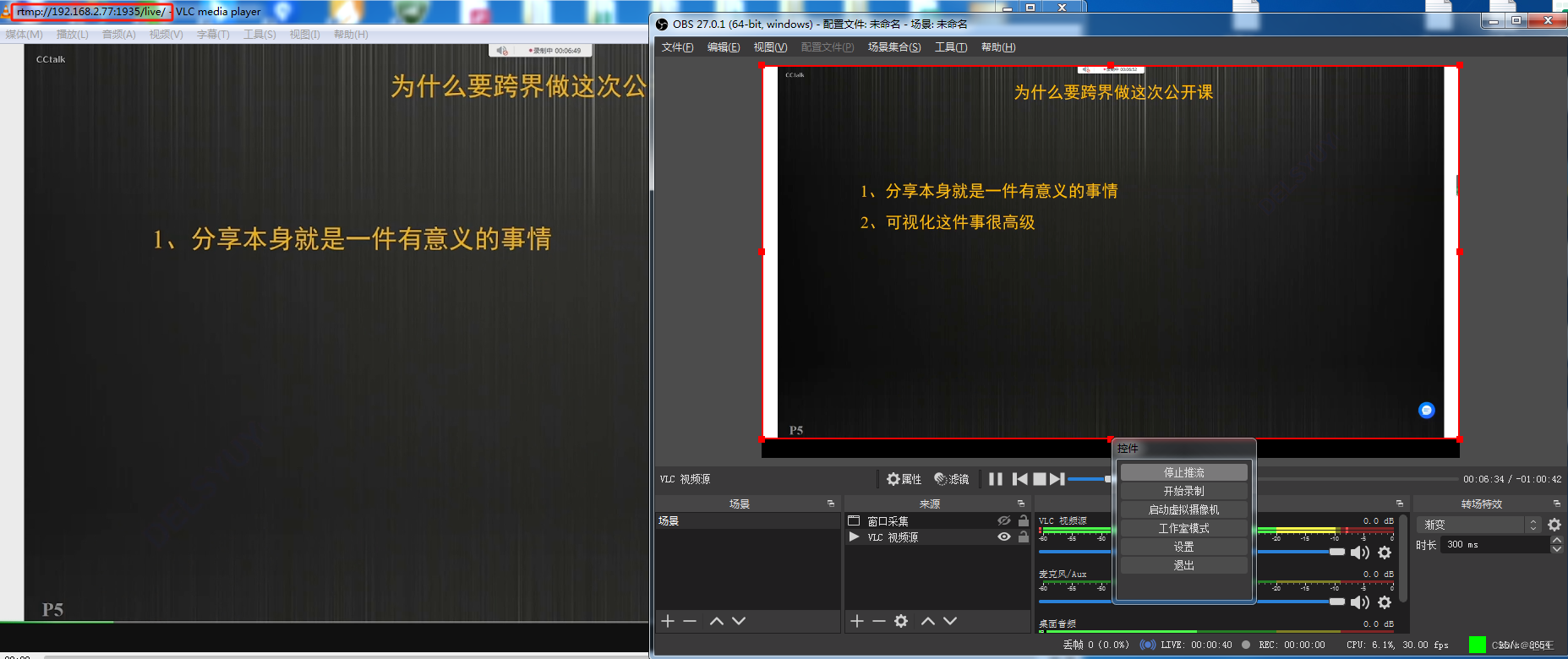您的位置:上海毫米网络优化公司 > 网站优化分享 >
相关推荐recommended
- 基于pear-admin-flask 的 flask 使用教程
- 分布式系统架构中的相关概念
- SQL Server2022版+SSMS安装(保姆级)
- 使用Docker搭建YesPlayMusic网易云音乐播放器并发布至公
- 在Flask中使用MySQL数据库
- Docker部署nginx,挂载,并配置nginx.conf
- 22年国赛tomcat后续(653556547)群
- esp8266用arduino连上阿里云(图文操作,100%成功)
- 探索设计模式的魅力:开启智慧之旅,AI与机器学习驱动的微服务设计模式探
- 【大数据】大数据概论与Hadoop
- 【粉丝福利社】《AIGC重塑金融:AI大模型驱动的金融变革与实践》(文
- SpringBoot整合Lombok以及各种使用技巧
- Spring 家族之 @JsonFormat 与 @DateTimeF
- 「PHP系列」PHP 多维数组详解
- 神州云服务平台(型号:DCC-CRL1000)基本配置教学视频
- 深入OceanBase内部机制:多租户架构下的资源隔离实现精讲
- 【spring】 ApplicationListener的使用及原理简
- 前馈神经网络解密:深入理解人工智能的基石
- 探索Spring AI:将人工智能与软件开发无缝融合
- 【讯飞星火大模型AI】SpringBoot项目快速接入讯飞星火API
- Qt5.14.2 深入理解Qt多线程编程,掌握线程池架构实现高效并发
- lua学习笔记20(lua中一些自带库的学习)
- SpringBoot3整合Redis&基础操作
- 4、jvm-垃圾收集算法与垃圾收集器
- MySql 安装,小白也可以学会成功安装的保姆级教程
- SQL中 JOIN 的两种连接类型:内连接(自然连接、自连接、交叉连接
- 【PHP系统学习】——Laravel框架数据库的连接以及数据库的增删改
- 基于YOLOv的目标追踪与无人机前端查看系统开发
- Bilstm双向长短期神经网络多输入单输出回归分析
- sentinel prometheus指标收集及资源规则正则表达式实现
利用Nginx搭建自己的rtmp服务器
作者:mmseoamin日期:2024-04-27
前几天的文章大疆机场开发五(直播功能和遇到的问题)中讲到,机场直播支持rtmp直播,如果我没有rtmp地址怎么办?这篇文章讲一下如何部署一个自己的rtmp服务器,nginx资源已上传,已配置好,可直接运用。
一、下载Nginx及响应模块
首先,去官方下载Nginx,还需要下载nginx-rtmp-module模块,将模块复制到Nginx的文件夹下面如图。
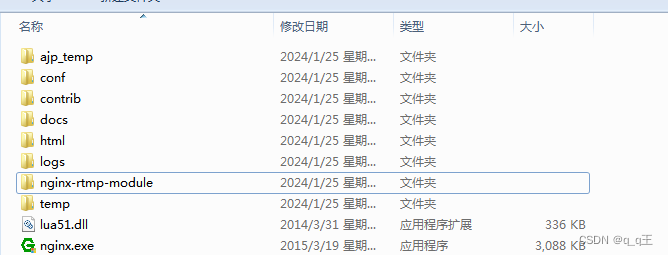
二、修改config文件
修改conf文件夹下面的conf文件,可复制里面的nginx.conf重命名,也可直接修改。
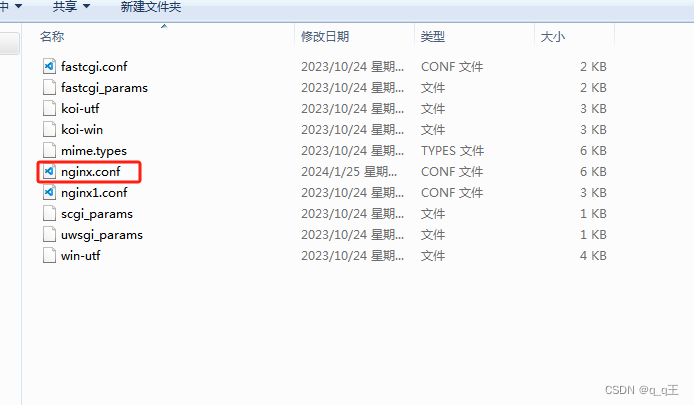
#user nobody;
# multiple workers works !
worker_processes 2;
#error_log logs/error.log;
#error_log logs/error.log notice;
#error_log logs/error.log info;
#pid logs/nginx.pid;
events {
worker_connections 8192;
# max value 32768, nginx recycling connections+registry optimization =
# this.value * 20 = max concurrent connections currently tested with one worker
# C1000K should be possible depending there is enough ram/cpu power
# multi_accept on;
}
rtmp {
server {
listen 1935;#监听端口,若被占用,可以更改
chunk_size 4000;#上传flv文件块儿的大小
application live { #创建一个叫live的应用
live on;#开启live的应用
allow publish 192.168.2.77;#
allow play all;
}
}
}
http {
#include /nginx/conf/naxsi_core.rules;
include mime.types;
default_type application/octet-stream;
#log_format main '$remote_addr:$remote_port - $remote_user [$time_local] "$request" '
# '$status $body_bytes_sent "$http_referer" '
# '"$http_user_agent" "$http_x_forwarded_for"';
#access_log logs/access.log main;
# # loadbalancing PHP
# upstream myLoadBalancer {
# server 127.0.0.1:9001 weight=1 fail_timeout=5;
# server 127.0.0.1:9002 weight=1 fail_timeout=5;
# server 127.0.0.1:9003 weight=1 fail_timeout=5;
# server 127.0.0.1:9004 weight=1 fail_timeout=5;
# server 127.0.0.1:9005 weight=1 fail_timeout=5;
# server 127.0.0.1:9006 weight=1 fail_timeout=5;
# server 127.0.0.1:9007 weight=1 fail_timeout=5;
# server 127.0.0.1:9008 weight=1 fail_timeout=5;
# server 127.0.0.1:9009 weight=1 fail_timeout=5;
# server 127.0.0.1:9010 weight=1 fail_timeout=5;
# least_conn;
# }
sendfile off;
#tcp_nopush on;
server_names_hash_bucket_size 128;
## Start: Timeouts ##
client_body_timeout 10;
client_header_timeout 10;
keepalive_timeout 30;
send_timeout 10;
keepalive_requests 10;
## End: Timeouts ##
#gzip on;
server {
listen 80;
server_name localhost;
#charset koi8-r;
#access_log logs/host.access.log main;
## Caching Static Files, put before first location
#location ~* \.(jpg|jpeg|png|gif|ico|css|js)$ {
# expires 14d;
# add_header Vary Accept-Encoding;
#}
# For Naxsi remove the single # line for learn mode, or the ## lines for full WAF mode
location / {
#include /nginx/conf/mysite.rules; # see also http block naxsi include line
##SecRulesEnabled;
##DeniedUrl "/RequestDenied";
##CheckRule "$SQL >= 8" BLOCK;
##CheckRule "$RFI >= 8" BLOCK;
##CheckRule "$TRAVERSAL >= 4" BLOCK;
##CheckRule "$XSS >= 8" BLOCK;
root html;
index index.html index.htm;
}
# For Naxsi remove the ## lines for full WAF mode, redirect location block used by naxsi
##location /RequestDenied {
## return 412;
##}
## Lua examples !
# location /robots.txt {
# rewrite_by_lua '
# if ngx.var.http_host ~= "localhost" then
# return ngx.exec("/robots_disallow.txt");
# end
# ';
# }
#error_page 404 /404.html;
# redirect server error pages to the static page /50x.html
#
error_page 500 502 503 504 /50x.html;
location = /50x.html {
root html;
}
# proxy the PHP scripts to Apache listening on 127.0.0.1:80
#
#location ~ \.php$ {
# proxy_pass http://127.0.0.1;
#}
# pass the PHP scripts to FastCGI server listening on 127.0.0.1:9000
#
#location ~ \.php$ {
# root html;
# fastcgi_pass 127.0.0.1:9000; # single backend process
# fastcgi_pass myLoadBalancer; # or multiple, see example above
# fastcgi_index index.php;
# fastcgi_param SCRIPT_FILENAME $document_root$fastcgi_script_name;
# include fastcgi_params;
#}
# deny access to .htaccess files, if Apache's document root
# concurs with nginx's one
#
#location ~ /\.ht {
# deny all;
#}
}
# another virtual host using mix of IP-, name-, and port-based configuration
#
#server {
# listen 8000;
# listen somename:8080;
# server_name somename alias another.alias;
# location / {
# root html;
# index index.html index.htm;
# }
#}
# HTTPS server
#
#server {
# listen 443 ssl spdy;
# server_name localhost;
# ssl on;
# ssl_certificate cert.pem;
# ssl_certificate_key cert.key;
# ssl_session_timeout 5m;
# ssl_prefer_server_ciphers On;
# ssl_protocols TLSv1 TLSv1.1 TLSv1.2;
# ssl_ciphers ECDH+AESGCM:ECDH+AES256:ECDH+AES128:ECDH+3DES:RSA+AESGCM:RSA+AES:RSA+3DES:!aNULL:!eNULL:!MD5:!DSS:!EXP:!ADH:!LOW:!MEDIUM;
# location / {
# root html;
# index index.html index.htm;
# }
#}
}
接着 双击 nginx.exe即可。如果没有报错即代表nginx运行成功,自己本地的rtmp默认地址为rtmp://ip:1935/live。
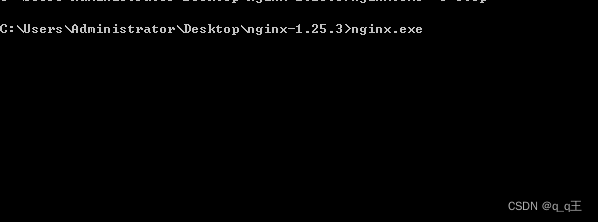
三、验证
我这边利用obs和VLC进行验证的。
1、添加VLC视频源

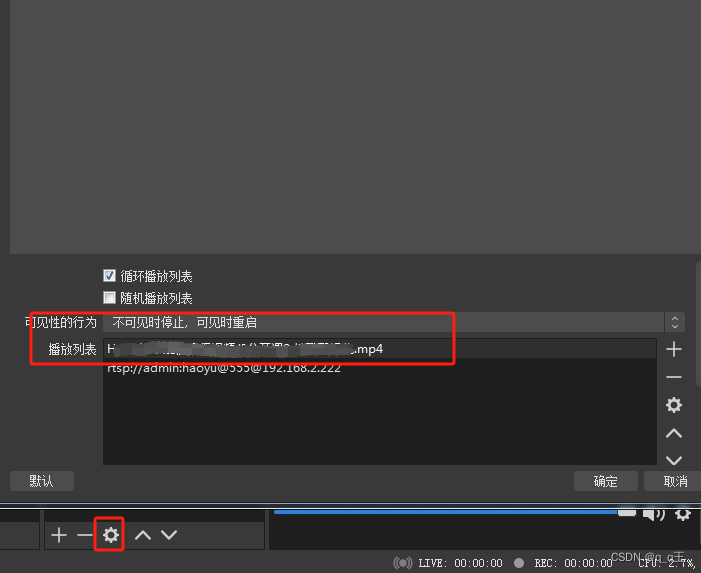
配置完成后点击右侧的开始推流。接着去VLC打开你本地的rtmp地址进行验证,如图即代表成功。
